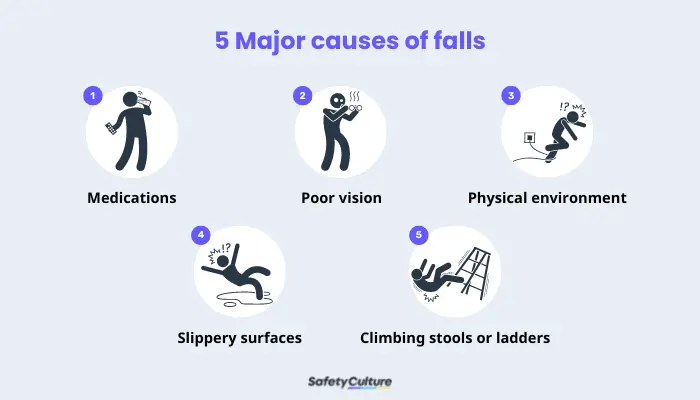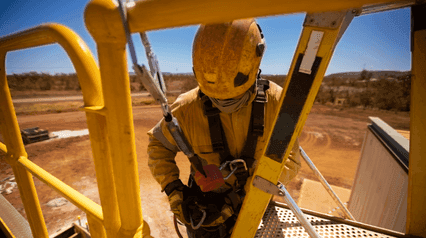What is Fall Prevention?
Fall prevention is a process that begins with understanding the risks of falling and ends with taking action to prevent them. Some of these measures are simple and easy to do, while others may require more time and effort. But all of them are worth it to help keep you safe and prevent falls.
What are the Five Major Causes of Falls?
A fall is defined as an occurrence resulting in a person coming to rest inadvertently on the floor or ground. According to the World Health Organization (WHO), falls are the second leading cause of unintentional injuries and deaths in the world. It can happen to anyone at any age. Since it’s one of the leading causes of injuries among older adults, it’s important to take steps to prevent them.
There are some risk factors that can make falls more likely to occur. Understanding these causes can help you take steps to prevent a fall from happening.
The five major causes of falls are:

Five Major Causes of Falls | SafetyCulture
- Medications – Some medications can cause dizziness and increase the risk of falling. Be sure to talk to your doctor about any medication you are taking and ask if they could contribute to falling.
- Poor vision – Vision problems can make it difficult to see obstacles in your path, increasing the risk of falling. If you have problems with your eyesight, be sure to see your doctor and get glasses or contacts as needed.
- Physical environment – Your physical environment can also play a role in falls. Be sure to remove any tripping hazards, such as loose rugs or electrical cords. If you are outside, be aware of your surroundings and be cautious of uncovered manholes.
- Slippery surfaces – Wet or icy surfaces can be difficult to walk on and lead to falls. Falls due to slipping often occur when it is rainy or working in a wet environment. Be careful when walking on slippery surfaces, and try to wear shoes with good traction.
- Climbing stools or ladders – Trying to climb on something too tall can cause you to fall off and injure yourself. Be sure to use a stool or chair that is the right height for you, and always use a handrail when climbing stairs.
What are the 4Ps of Fall Prevention?
While the risks are high, falls are still preventable, starting with the individual. There are 4 strategies or approaches to fall prevention, known as the 4Ps. They stand for:
Pain
Pain is the number one symptom that people experience before falling. It is important to pay attention to any pain that you are feeling and address it as soon as possible. There are many different types of pain, so it is essential to be specific when describing it to your healthcare provider.
Position
Your position can affect your balance and put you at risk of falling. Be sure to sit or stand up straight and avoid crossing your legs. If you are standing, be sure to distribute your weight evenly between both feet.
Placement
Do you need something within reach? Placement of objects can be vital to your safety. Make sure that any items you need are within arm’s reach and not clustered together so that you can grab them quickly if you need to.
Personal Needs
Do you have any medical conditions or take any medications that could make you dizzy or lightheaded? Be sure to tell your healthcare provider about any medications you are taking, as well as any conditions you have that could make you more likely to fall.
Fall Prevention Safety Tips in the Workplace
According to the US Centers for Disease Control (CDC), falls are a big issue in the workplace, especially in the construction industry.
This is why it is essential to ensure fall protection through safe work practices. Below are some fall prevention safety tips to know when at your workplace:
Conduct Fall Toolbox Talks
Conducting regular safety meetings to discuss the potential hazards of falling is one way to mitigate the risks associated with falls. Workers and employees will be more aware of what to avoid and do to prevent falls in their area.
Inspect Work Areas
Before starting work, it is important to inspect the work area for potential fall hazards such as slippery surfaces, unprotected edges, and uncovered holes. Aside from this, managers must also check if workers are wearing appropriate Personal Protective Equipment (PPE) on the field.
To speed up this process, they can use digital checklists for site inspections, PPE checks, and working at heights.
Use the Right Equipment
When working at heights, using the proper safety and height access equipment, such as a harness, lanyard, and fall arrest system is important. Make sure that all tools are in the right condition when using them through regular equipment inspections and maintenance checks.
Follow Safety Procedures
Standardization of safety practices is also crucial for preventing falls in the workplace. For this reason, it is important to follow safety procedures when working at heights, such as maintaining three points of contact, ensuring flat surfaces are clean and free of spills and using a ladder safely.
Wear Proper Footwear
It is important to wear proper footwear when working at heights, as this can help prevent slips and falls. Make sure to wear sturdy footwear that has good traction on surfaces.
Be Aware of Weather Conditions
Working in inclement weather can make it more difficult to maintain traction, so it is essential to be aware of the forecast and take necessary precautions.
Create Your Own Fall Prevention Safety Checklist
Eliminate manual tasks and streamline your operations.
Get started for FREE


